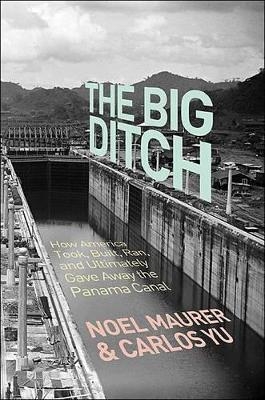
The Big Ditch
How America Took, Built, Ran, and Ultimately Gave Away the Panama Canal
Seiten
2010
Princeton University Press (Verlag)
978-0-691-14738-3 (ISBN)
Princeton University Press (Verlag)
978-0-691-14738-3 (ISBN)
On August 15, 1914, the Panama Canal officially opened for business, forever changing the face of global trade and military power, as well as the role of the United States on the world stage. Examining the Canal's influence on Panama, the United States, and the world, this title chronicles the economic and political history of the Canal.
On August 15, 1914, the Panama Canal officially opened for business, forever changing the face of global trade and military power, as well as the role of the United States on the world stage. The Canal's creation is often seen as an example of U.S. triumphalism, but Noel Maurer and Carlos Yu reveal a more complex story. Examining the Canal's influence on Panama, the United States, and the world, "The Big Ditch" deftly chronicles the economic and political history of the Canal, from Spain's earliest proposals in 1529 through the final handover of the Canal to Panama on December 31, 1999, to the present day. The authors show that the Canal produced great economic dividends for the first quarter-century following its opening, despite massive cost overruns and delays. Relying on geographical advantage and military might, the United States captured most of these benefits. By the 1970s, however, when the Carter administration negotiated the eventual turnover of the Canal back to Panama, the strategic and economic value of the Canal had disappeared.
And yet, contrary to skeptics who believed it was impossible for a fledgling nation plagued by corruption to manage the Canal, when the Panamanians finally had control, they switched the Canal from a public utility to a for-profit corporation, ultimately running it better than their northern patrons. A remarkable tale, "The Big Ditch" offers vital lessons about the impact of large-scale infrastructure projects, American overseas interventions on institutional development, and the ability of governments to run companies effectively.
On August 15, 1914, the Panama Canal officially opened for business, forever changing the face of global trade and military power, as well as the role of the United States on the world stage. The Canal's creation is often seen as an example of U.S. triumphalism, but Noel Maurer and Carlos Yu reveal a more complex story. Examining the Canal's influence on Panama, the United States, and the world, "The Big Ditch" deftly chronicles the economic and political history of the Canal, from Spain's earliest proposals in 1529 through the final handover of the Canal to Panama on December 31, 1999, to the present day. The authors show that the Canal produced great economic dividends for the first quarter-century following its opening, despite massive cost overruns and delays. Relying on geographical advantage and military might, the United States captured most of these benefits. By the 1970s, however, when the Carter administration negotiated the eventual turnover of the Canal back to Panama, the strategic and economic value of the Canal had disappeared.
And yet, contrary to skeptics who believed it was impossible for a fledgling nation plagued by corruption to manage the Canal, when the Panamanians finally had control, they switched the Canal from a public utility to a for-profit corporation, ultimately running it better than their northern patrons. A remarkable tale, "The Big Ditch" offers vital lessons about the impact of large-scale infrastructure projects, American overseas interventions on institutional development, and the ability of governments to run companies effectively.
Noel Maurer is associate professor of business administration at Harvard Business School. His books include "The Power and the Money, The Politics of Property Rights", and "Mexico since 1980". Carlos Yu is an economic historian and private consultant based in New York City.
List of Illustrations vii List of Tables ix Preface xiii Chapter One: Introduction to the Ditch 1 Chapter Two: Before the Ditch 13 Chapter Three: Preparing the Ditch 55 Chapter Four: Digging the Ditch 97 Chapter Five: Crossing the Ditch 139 Chapter Six: Passed by the Ditch 189 Chapter Seven: Sliding into Irrelevancy 212 Chapter Eight: Ditching the Ditch 264 Chapter Nine: Concluding the Ditch 313 Notes 333 Index 401
| Erscheint lt. Verlag | 28.11.2010 |
|---|---|
| Zusatzinfo | 6 Maps |
| Verlagsort | New Jersey |
| Sprache | englisch |
| Maße | 152 x 235 mm |
| Gewicht | 482 g |
| Themenwelt | Geschichte ► Teilgebiete der Geschichte ► Wirtschaftsgeschichte |
| Technik ► Fahrzeugbau / Schiffbau | |
| ISBN-10 | 0-691-14738-8 / 0691147388 |
| ISBN-13 | 978-0-691-14738-3 / 9780691147383 |
| Zustand | Neuware |
| Haben Sie eine Frage zum Produkt? |
Mehr entdecken
aus dem Bereich
aus dem Bereich
eine Globalgeschichte des Kapitalismus
Buch | Hardcover (2023)
C.H.Beck (Verlag)
38,00 €


